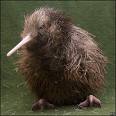Conservation
 Kiwis have long been the cherished national mascot of New Zealand. Though they have enjoyed complete legal protection since 1896 and large tracts of pristine forests have been set aside in parks and reserves, their numbers are dropping by 5.8 perecnt each year. In 1996 scientists estimated the brown kiwi population at 35,000 birds. They predict that if current trends continue that number will drop to 20,000 by the year 2006. Kiwi populations have been on this downward slide ever since humans arrived in New Zealand more than a thousand years ago.
Kiwis have long been the cherished national mascot of New Zealand. Though they have enjoyed complete legal protection since 1896 and large tracts of pristine forests have been set aside in parks and reserves, their numbers are dropping by 5.8 perecnt each year. In 1996 scientists estimated the brown kiwi population at 35,000 birds. They predict that if current trends continue that number will drop to 20,000 by the year 2006. Kiwi populations have been on this downward slide ever since humans arrived in New Zealand more than a thousand years ago.
New Zealand is one of the most isolated large island groups in the world. There had been no large predators on the islands of New Zealand between their separation from the other continental land masses of Gondwanaland at the end of the Cretaceous period, 130 to 80 million years ago, and the arrival of the first human settlers. The only native land mammals were two species of small bats. Many birds lost the power of flight in response to the absence of significant predators. There were two orders of ratites, flightless birds, endemic to New Zealand; the Apterygiformes (kiwis) and the Dinornithiformes (moas). The moas, diurnal grazers and browsers occupying scrubland and forest edges, were divided into 13-29 species. They ranged in size from that of a domestic turkey to one species that stood taller than three meters and weighed 350 kg.
Around 1000 CE the Maoris, settlers from East Polynesia, were the first humans to reach New Zealand. They brought with them the domestic dog and the Polynesian rat. Maoris actively hunted the native birds and burned the lowland forests to clear land for their sweet-potato-based agriculture. The combination of intensive hunting pressure and large-scale deforestation drove all of the moas and several other species of flightless birds to extinction. Although the kiwis' smaller size, nocturnal habits, and preference for deep-forest habitat made them less vulnerable than their larger cousins the moas, they began to disappear from portions of their historic ranges. This process of range constriction continued with the arrival of European settlers in the 19th century.
Europeans introduced a variety of additional predatory species, both deliberately and accidentally. From domestic dogs and cats to stoats, weasels, ferrets, bushy-tailed possums and rats, they all have taken their toll on the numbers and reproductive success of the ground-nesting kiwis. Stoats alone kill 60 percent of all brown kiwi chicks hatched each year. A single dog is believed to have killed 500 of the 800 kiwis estimated to reside in the Waitangi Forest on North Island in under 2 months. While adult kiwis are usually feisty enough to defend themselves against the smaller predators, their eggs and newly hatched young are extremely vulnerable to predation.
 Massive education campaigns are involving the entire New Zealand population in the fight to save their national emblem. Rural residents contribute to conservation efforts by keeping their dogs contained and monitoring kiwi populations in their neighborhoods. Farmers are asked to fence their stock out of critical kiwi habitat to prevent forest degradation. Foresters are asked to refrain from burning brush off of newly cleared lands to avoid burning the resident kiwis who are often reluctant to leave their territories even after all the trees are gone. If they must burn they are encouraged to wait at least two months after cutting to allow kiwis time to move on. Both farmers and foresters are participating in the control of the introduced pest species. The New Zealand Department of Conservation has recently initiated a five-year $6.6 million program to research better stoat eradication techniques.
Massive education campaigns are involving the entire New Zealand population in the fight to save their national emblem. Rural residents contribute to conservation efforts by keeping their dogs contained and monitoring kiwi populations in their neighborhoods. Farmers are asked to fence their stock out of critical kiwi habitat to prevent forest degradation. Foresters are asked to refrain from burning brush off of newly cleared lands to avoid burning the resident kiwis who are often reluctant to leave their territories even after all the trees are gone. If they must burn they are encouraged to wait at least two months after cutting to allow kiwis time to move on. Both farmers and foresters are participating in the control of the introduced pest species. The New Zealand Department of Conservation has recently initiated a five-year $6.6 million program to research better stoat eradication techniques.
Conservationists are working to establish predator-free reserves on off shore islands and fenced areas to function as safe population reservoirs. Operation Nest Egg collects kiwi eggs from the wild to be reared in captivity or on these predator free reserves. The birds are reintroduced into their native forests when they are large enough to defend themselves from stoats and other small predators. This program has increased chick survival rates from five to 85 percent. Reintroduced birds are being monitored to learn whether they will be able to reproduce successfully.


